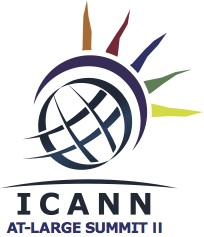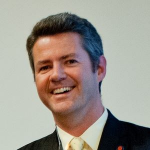Olivier Crépin-Leblond – Chair of the At-Large Advisory Committee (ALAC)
1. From your perspective as ALAC chair, what is the importance of ATLAS II?
It is widely understood today that the first At-Large Summit (ATLAS) was the starting point and catalyst for a lot of today’s ALAC and Regional leaders because it was the first time they really understood the topics at ICANN, the way the At-Large Community was structured and the process by which end user input became policy in At-Large.
The barriers to entry are multiple: It is true that ICANN has its own vocabulary of acronyms and other terms which are difficult to understand at first. Then, there is a huge variety of issues which come through the emails, one after the other, and often, new ALS participants very quickly feel completely overwhelmed by the daily flood of information in their mailbox.
Because of this, it is important to be able to discuss these issues with other people and to experience an ICANN meeting by attending it in person. Internet Governance in the ICANN context is not a topic which can be learnt in a book – you need to be there to feel it, to experience it, to share issues with colleagues and to gain the confidence to be able to participate more in the future.
ATLAS II will provide the ability for our At-Large Structure representatives, many of whom have never attended an ICANN meeting, to experience the meeting, to share issues and to work together with other like-minded people on topics which they, themselves, have chosen to work on.
In light of the NetMundial Meeting which is going to be the first of many meetings discussing Internet Governance worldwide, ATLAS II comes at a key moment in time. In parallel, ICANN is starting the discussion on the transition of the Stewardship of the IANA Contract, another key issue in which Internet User involvement is needed. Later in the year, the International Telecommunications Union (ITU) will conduct its plenipotentiary conference which might include discussions on inclusion of significant Internet related issues. The ITU is purely governmental. It is very important that our At-Large Structure representatives can gain a better understanding of how they can contribute to the debate today and bring back the message to their local communities worldwide that the path of multi-stakeholder input is the natural path for the Internet to remain open and stimulate growth and opportunity worldwide. Not only governments; not only private sector; not only civil society — but a balanced multi-stakeholder model.
The multi-stakeholder model at ICANN would be incomplete without the involvement of end users. But rather than just being involved passively, the ATLAS II provides this community the opportunity to get actively involved. This is historical. It is the birth of an operational bottom-up multi-stakeholder model as opposed to a purely theoretical model. Our ALS representatives might not feel like pioneers, but they really are. That’s what I find exciting about the ATLAS II.
2. What is the goal or objective that you intend to see accomplished by ATLAS II?
There are several goals and objectives to be achieved:
1. Strengthening the bottom-up structure of the At-Large Community by building capacity of At-Large policies and processes of for our At-Large Structures. This is really needed in order to help engagement of At-Large members all the way to the grass-roots organisations that make-up At-Large.
2. Further develop the At-Large Community’s capacity for engagement in ICANN by increasing its knowledge and understanding of the key issues confronting ICANN and ICANN’s roles and responsibilities. Not understanding ICANN processes and issues is a barrier to engagement. The ATLAS II aims to make it easier for At-Large Structure representatives to act as ambassadors and bring knowledge about ICANN and its processes and key issues back to their communities worldwide.
3. Plan for the next stage of the ALAC/At-Large community’s development. The Internet keeps on evolving at a very fast pace. ICANN is also evolving very quickly. As a key component part of ICANN, the ALAC and At-Large community must also evolve, improve its processes and succeed in both improving end user understanding of ICANN and end user input into the ICANN processes. We need to enable our local communities through At-Large Structures.
4. Allow ICANN to showcase a key component of its bottom-up multi-stakeholder environment to the rest of the world at a time pivotal to ICANN and the Internet multi-stakeholder model. The At-Large Component of ICANN is a unique global structure designed to provide a better balance in input from the world’s five regions. As a very diverse community that has produced more than 50 policy Statements in 2013, At-Large is the only operational bottom-up end-users component that feeds into the ICANN multi-stakeholder environment. This unique demonstration of bottom-up multi-stakeholder processes should be showcased as an example to behold in wider Internet governance circles, especially in light of unfair criticism that multi-stakeholder governance does not work.
In summary, we have a very unique group of groups around the world, just like the Internet is a very unique network of networks. ATLAS II participants will be asked to work and reach consensus on very real issues which will be key to the future of the multi-stakeholder model as we know it. This consensus will be reflected in a report.
3. What are the expected results in terms of regional and global participation in ATLAS II?
A full, global involvement is crucial. Multi-stakeholder bottom-up governance is often accused of privileging the few that are able to finance themselves to the table and to be controlled by those who have the loudest voice and the most money. By financing ATLAS II participants to come and meet face to face in London and take part in ICANN’s 50th meeting, ICANN has removed this concern. The expectation is now that all voices will be heard and listened to and that all voices will be relayed back to the homes of the 160 At-Large Structure representatives worldwide. This is a special opportunity to tell the world that multi-stakeholder decisional discussions are possible and a flavour of this discussion is in operation at ICANN.
4. What do you consider are the next steps to be followed after ATLAS II to provide continuity and implementation of proposals that are developed there?
ATLAS II participants will draft five (5) reports based on the outcome of their discussions. These will be presented to the Board and their recommendations will be considered by the Board. I also expect that the reports and recommendations will be put out to ICANN Public Comment for greater distribution and for gathering of feedback from other communities. ATLAS II participants will then be encouraged to share the 5 reports with their communities and to get their communities to comment directly on the reports using the ICANN Public Comment system.
I also expect that the issues raised in the ATLAS II will encourage participants to continue work in At-Large’s many working groups. Should issues not fit in currently available At-Large working groups, the ATLAS II follow-up working groups could be created during the meeting and I hope that a significant number of ALS representatives will continue work in those working groups.
Overall, the ATLAS II will be the entry point into the world of ICANN and of multi-stakeholder bottom-up governance for many of our ALS representatives. The vast majority of today’s ALAC and Regional Leaders really understood and got involved more with the At-Large Community during the first ATLAS in Mexico City. With the challenges arriving later this year but also in future years, the ATLAS II is a unique opportunity for participants to explore their future in positions of responsibility in defining the future of the Internet and much much more.
An Introduction to the At-Large Advisory Committee (ALAC) and the At-Large Community -Abril 2013

